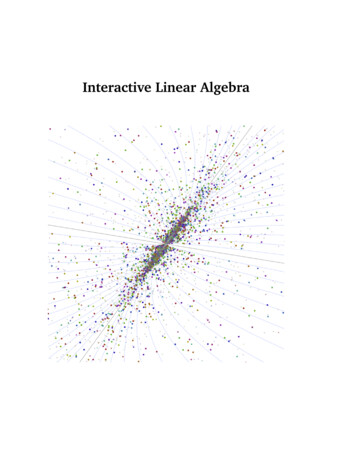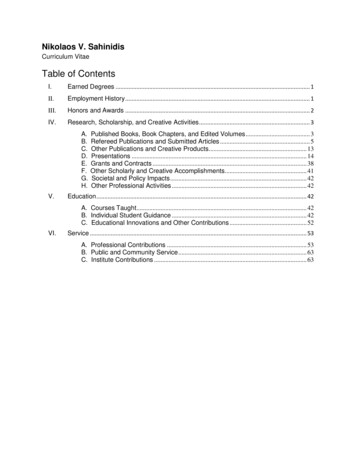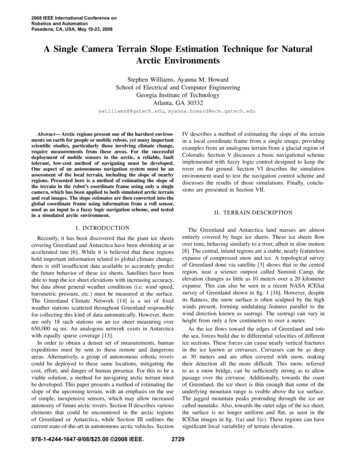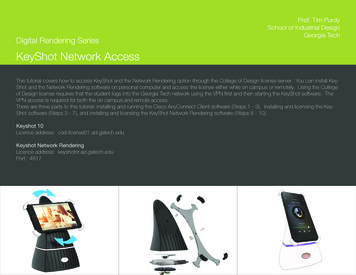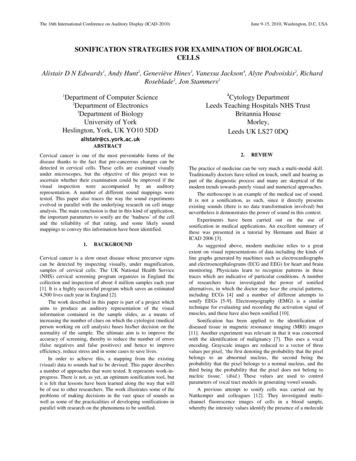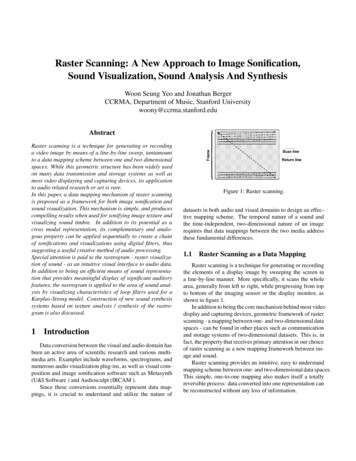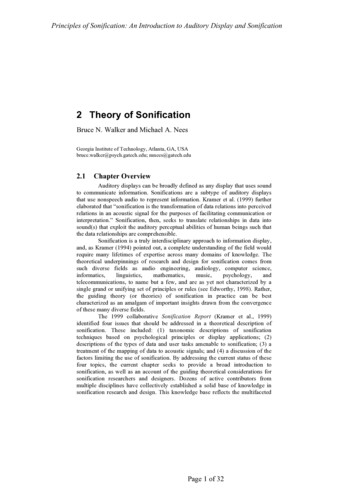
Transcription
Principles of Sonification: An Introduction to Auditory Display and Sonification2 Theory of SonificationBruce N. Walker and Michael A. NeesGeorgia Institute of Technology, Atlanta, GA, USAbruce.walker@psych.gatech.edu; mnees@gatech.edu2.1Chapter OverviewAuditory displays can be broadly defined as any display that uses soundto communicate information. Sonifications are a subtype of auditory displaysthat use nonspeech audio to represent information. Kramer et al. (1999) furtherelaborated that “sonification is the transformation of data relations into perceivedrelations in an acoustic signal for the purposes of facilitating communication orinterpretation.” Sonification, then, seeks to translate relationships in data intosound(s) that exploit the auditory perceptual abilities of human beings such thatthe data relationships are comprehensible.Sonification is a truly interdisciplinary approach to information display,and, as Kramer (1994) pointed out, a complete understanding of the field wouldrequire many lifetimes of expertise across many domains of knowledge. Thetheoretical underpinnings of research and design for sonification comes fromsuch diverse fields as audio engineering, audiology, computer psychology,andtelecommunications, to name but a few, and are as yet not characterized by asingle grand or unifying set of principles or rules (see Edworthy, 1998). Rather,the guiding theory (or theories) of sonification in practice can be bestcharacterized as an amalgam of important insights drawn from the convergenceof these many diverse fields.The 1999 collaborative Sonification Report (Kramer et al., 1999)identified four issues that should be addressed in a theoretical description ofsonification. These included: (1) taxonomic descriptions of sonificationtechniques based on psychological principles or display applications; (2)descriptions of the types of data and user tasks amenable to sonification; (3) atreatment of the mapping of data to acoustic signals; and (4) a discussion of thefactors limiting the use of sonification. By addressing the current status of thesefour topics, the current chapter seeks to provide a broad introduction tosonification, as well as an account of the guiding theoretical considerations forsonification researchers and designers. Dozens of active contributors frommultiple disciplines have collectively established a solid base of knowledge insonification research and design. This knowledge base reflects the multifacetedPage 1 of 32
Principles of Sonification: An Introduction to Auditory Display and Sonificationnature of sonification, and this collaborative, multidisciplinary approach to thefield has allowed us today to lay down an overview of the principles employed insonification research and design. We attempt to draw upon the insights ofrelevant domains of research, and where necessary, offer areas where futureresearchers could answer unresolved questions or make fruitful clarifications orqualifications to the current state of the field. In many cases, we will point theinterested reader to another more detailed chapter in this book, or to otherexternal sources for more extensive coverage.2.2Sonification and Auditory DisplaysSonifications are a relatively recent subset of auditory displays. As inany information system (see Figure 2.1), an auditory display offers a relaybetween the information source and the information receiver (see Kramer, 1994;Shannon, 1998/1949). In the case of an auditory display, the data of interest areconveyed to the human listener through sound.Figure 2.1: General description of a communication systemAlthough investigations of audio as an information display date backover 50 years (see Frysinger, 2005), digital computing technology has morerecently meant that auditory displays of information have become ubiquitous.Edworthy (1998) argued that the advent of auditory displays and audio interfaceswas practically inevitable given the ease and cost efficiency with whichcomputers can now produce sound. Devices ranging from cars to computers tocell phones to microwaves pervade our environments, and all of these devicesnow use intentional sound1 to deliver messages to the user.The rationales and motivations for displaying information using sound(rather than a visual presentation, etc.) have been discussed at length elsewhere.Briefly, though, auditory displays exploit the superior ability of the human1Intentional sounds are purposely engineered to perform as an information display (seeWalker & Kramer, 1996), and stand in contrast to incidental sounds, which are nonengineered sounds that occur as a consequence of the normal operation of a system (e.g., acar engine running). Incidental sounds may be quite informative (e.g., the sound of windrushing past can indicate a car’s speed), though this characteristic of incidental sounds isserendipitous rather than designed. The current chapter is confined to a discussion ofintentional sounds.Page 2 of 32
Principles of Sonification: An Introduction to Auditory Display and Sonificationauditory system to recognize temporal changes and patterns (Bregman, 1990;Flowers, Buhman, & Turnage, 1997; Flowers & Hauer, 1995; Garner &Gottwald, 1968; Kramer et al., 1999; McAdams & Bigand, 1993; Moore, 1997).As a result, auditory displays may be the most appropriate modality when theinformation being displayed has complex patterns, changes in time, includeswarnings, or calls for immediate action. Second, in practical work environmentsthe operator is often unable to look at, or unable to see, a visual display. Thevisual system might be busy with another task (Fitch & Kramer, 1994; Wickens& Liu, 1988), or the perceiver might be visually impaired, either physically or asa result of environmental factors such as smoke or line of sight (Fitch & Kramer,1994; Kramer et al., 1999; Walker, 2002; Walker & Kramer, 2004; Wickens,Gordon, & Liu, 1998), or the visual system may be overtaxed with information(see Brewster, 1997; M. L. Brown, Newsome, & Glinert, 1989). Third, auditoryand voice modalities have been shown to be most compatible when systemsrequire the processing or input of verbal-categorical information (Salvendy,1997; Wickens & Liu, 1988; Wickens, Sandry, & Vidulich, 1983). Otherfeatures of auditory perception that suggest sound as an effective datarepresentation technique include our ability to monitor and process multipleauditory data sets (parallel listening) (Fitch & Kramer, 1994), and our ability forrapid auditory detection, especially in high stress environments (Kramer et al.,1999; Moore, 1997). Finally, with mobile devices becoming increasingly smallerin size, sound may be a compelling display mode as visual displays decrease insize (Brewster & Murray, 2000). For a more complete discussion of the benefitsof (and potential problems with) auditory displays, see Kramer (1994; Kramer etal., 1999), Sanders and McCormick (1993), Johannsen (2004), and Stokes(1990).2.3Towards a Taxonomy of Auditory Display & SonificationA taxonomic description of auditory displays in general, andsonifications in particular, could be organized in any number of ways. Categoriesoften emerge from either the function of the display or the technique ofsonification, and either could serve as the logical foundation for a taxonomy. Inthis chapter we offer a discussion of ways of classifying auditory displays andsonifications according to both function and technique, although, as ourdiscussion will elaborate, they are very much inter-related.Sonifications are clearly a subset of auditory display, but it is not clear,in the end, where the exact boundaries should be drawn. Categorical definitionswithin the sonification field tend to be loosely enumerated and are somewhatflexible. For example, auditory representations of box-and-whisker plots,diagrammatic information, and equal-interval time series data have all beencalled sonification, and, in particular, “auditory graphs,” but all of these displaysare clearly quite different from each other in both form and function. Ultimately,the name assigned to a sonification is much less important than its ability toPage 3 of 32
Principles of Sonification: An Introduction to Auditory Display and Sonificationcommunicate the intended information. Thus, the taxonomic description thatfollows is intended to parallel conventional naming schemes found in theliterature, but these descriptions should not be taken to imply that clear cutboundaries and distinctions are always possible to draw, nor are they crucial tothe creation of a successful display.2.3.1Functions of sonificationGiven that sound has some inherent properties that should provebeneficial as a medium for information display, we can begin by consideringsome of the functions that auditory displays might perform. Buxton (1989) andothers (e.g., Edworthy, 1998; Kramer, 1994; Walker & Kramer, 2004) havedescribed the function of auditory displays in terms of three broad categories: (1)alarms, alerts, and warnings; (2) status, process, and monitoring messages; and(3) data exploration. To this we would add: (4) art and entertainment.2.3.1.1Alerting functionsAlerts and notifications refer to sounds used to indicate that somethinghas, or is about to occur, or that the listener should immediately attend tosomething in the environment (see Buxton, 1989; Sanders & McCormick, 1993;Sorkin, 1987). Alerts and notifications tend to be simple and particularly overt.The message conveyed is information-poor. For example, a beep is often used toindicate that the cooking time on a microwave oven has expired. There isgenerally little information as to the details of the event—the microwave beepmerely indicates that the time has expired, not necessarily that the food is fullycooked. Another commonly heard alert is a doorbell—the basic ring does notindicate who is at the door, or why.Alarms and warnings are alert or notification sounds that are intendedto convey the occurrence of a constrained class of events, usually adverse, thatcarry particular urgency in that they require immediate response or attention (seeHaas & Edworthy, 2006). Warning signals presented in the auditory modalityautomatically capture spatial attention better than visual warning signals (Spence& Driver, 1997). A well-chosen alarm or warning should, by definition, carryslightly more information than a simple alert (i.e., the user knows that an alarmindicates an adverse event that requires an immediate action); however, thespecificity of the information about the adverse event generally remains limited.Fire alarms, for example, signal an adverse event (a fire) that requires immediateaction (evacuation), but the alarm does not carry information about the locationof the fire or its severity.More complex (and modern) kinds of alarms attempt to encode moreinformation into the auditory signal. Examples range from families of categoricalwarning sounds in healthcare situations (e.g., Sanderson, in press) to helicoptertelemetry and avionics data being used to modify a given warning sound (e.g.,“trendsons”, Edworthy, Hellier, Aldrich, & Loxley, 2004). These sounds,Page 4 of 32
Principles of Sonification: An Introduction to Auditory Display and Sonificationdiscussed at length by Edworthy and Hellier (2006), blur the line between alarmsand status indicators, discussed next.2.3.1.2Status and progress indicating functionsAlthough in some cases sound performs a basic alerting function, otherscenarios require a display that offers more detail about the information beingrepresented with sound. The current or ongoing status of a system or processoften needs to be presented to the human listener, and auditory displays havebeen applied as dynamic status and progress indicators. In these instances,sound takes advantage of “the listener's ability to detect small changes inauditory events or the user's need to have their eyes free for other tasks” (Krameret al., 1999 p. 3). Auditory displays have been developed for uses ranging frommonitoring models of factory process states (see Gaver, Smith, & O'Shea, 1991;Walker & Kramer, 2005), to patient data in an anesthesiologist's workstation(Fitch & Kramer, 1994), blood pressure in a hospital environment (M. Watson,2006), and telephone hold time (Kortum, Peres, Knott, & Bushey, 2005).2.3.1.3Data exploration functionsThe third functional class of auditory displays are those designed topermit data exploration. These are what is generally meant by the term“sonification”, and are usually intended to encode and convey information aboutan entire data set or relevant aspects of the data set. Sonifications designed fordata exploration differ from status or process indicators in that they use sound tooffer a more holistic portrait of the data in the system rather than condensinginformation to capture a momentary state such as with alerts and processindicators. Auditory graphs (for representative work, see L. M. Brown &Brewster, 2003; Flowers & Hauer, 1992, 1993, 1995; Smith & Walker, 2005)and interactive sonifications (see Chapter 13 in this volume and Hermann &Hunt, 2005) are typical exemplars of sonifications designed for data explorationpurposes.2.3.1.4Art and entertainmentAs the sound-producing capabilities of computing systems haveevolved, so too has the field of computer music. In addition to yielding warningsand sonifications, events and data sets can be used as the basis for musicalcompositions. Often the resulting performances include a combination of thetypes of sounds discussed to this point, in addition to more traditional musicalelements. While the composers often attempt to convey something to the listenerthrough these sonifications, it is not for the pure purpose of information delivery.Recent examples of sonification compositions have ranged from sonifications ofhuman electroencephalogram (EEG) data ("Listening to the mind listening:Concert of sonifications at the Sydney Opera House", 2004), to global economicPage 5 of 32
Principles of Sonification: An Introduction to Auditory Display and Sonificationand health data ("Global music - The world by ear", 2006), among others. Quinn(2001, 2003) has used data sonifications to drive ambitious musical works, andhe has published entire albums of his compositions.2.3.2Sonification techniques and approachesde Campo (2006) offered a sonification design map that featured threebroad categorizations of sonification approaches: (1) event-based; (2) modelbased; and (3) continuous. Again, the definitional boundaries to taxonomicdescriptions of sonifications are indistinct and often overlapping. We provide abrief overview of approaches and techniques employed in sonification below; fora more detailed treatment, see later chapters in this volume.2.3.2.1Modes of interactionA prerequisite to a discussion of sonification approaches is a basicunderstanding of the nature of the interaction that may be available to a user ofan auditory display. Interactivity can be considered as a dimension along whichdifferent displays can be classified, ranging from completely non-interactive tocompletely user-initiated. For example, in some instances the listener maypassively take in a display without being given the option to actively manipulatethe display (by controlling the speed of presentation, pausing, fast-forwarding, orrewinding the presentation, etc.). The display is simply triggered and plays in itsentirety while the user listens. Sonifications at this non-interactive end of thedimension have been called “concert mode” (Walker & Kramer, 1996) or “tourbased” (Franklin & Roberts, 2004). Alternatively, the listener may be able toactively control the presentation of the sonification. In some instances, the usermight be actively choosing and changing presentation parameters of the display(see L. M. Brown, Brewster, & Riedel, 2002). In other cases, user input andinteraction may be the required catalyst that drives the presentation of sounds(see Hermann & Hunt, 2005). Sonifications more toward this interactive end ofthe spectrum have been called “conversation mode” (Walker & Kramer, 1996) or“query based” (Franklin & Roberts, 2004) sonification, and include “interactivesonification” (see Chapter 13 in this volume and Hermann & Hunt, 2005).Walker has pointed out that for most sonifications to be useful (and certainlythose intended to support learning and discovery), there needs to be at least somekind of interaction capability, even if it is just the ability to pause or replay aparticular part of the sound (e.g., Walker & Cothran, 2003; Walker & Lowey,2004).2.3.2.2Event-based sonificationEvent-based approaches to sonification describe those displays wherethe data are such that parameter mapping can be employed (de Campo, 2006;Hermann & Hunt, 2005). Parameter mapping represents changes in some dataPage 6 of 32
Principles of Sonification: An Introduction to Auditory Display and Sonificationdimension with changes in an acoustic dimension to produce a sonification(Hermann & Hunt, 2005). By definition, sonification represents changes in datawith changes in one or more sound attributes (Kramer et al., 1999).Manipulatable perceptual dimensions of sound, therefore, must be mapped tocorrespond to changes in data. Sound, however, has a multitude of changeabledimensions (see Kramer, 1994; Levitin, 1999) that allow for a large design spacewhen mapping data to audio. In order for parameter mapping to be used in asonification, the dimensionality of the data must be constrained such that aperceivable display is feasible, thus parameter mapping tends to result in a morelow dimension display than the model-based approaches discussed below. Eventbased approaches to sonification have typically employed a somewhat passivemode of interaction. Indeed, some event-based sonifications (e.g., alerts andnotifications, etc.) are designed to be brief and would offer little opportunity foruser interaction. Other event-based approaches that employ parameter mappingfor purposes of data exploration (e.g., auditory graphs) could likely benefit fromadopting some combination of passive listening and active listenerinteraction.2.3.2.3Model-based sonificationModel-based approaches to sonification differ from event-basedapproaches in that instead of mapping data parameters to sound parameters, thedisplay designer builds a virtual model with which the listener interacts such thatthe model’s “properties are informed by the data” (de Campo, 2006, p. 2). Amodel constitutes a virtual object with which the user can interact, and the user’sinput drives the sonification such that the model is “a dynamic system capable ofa dynamic behavior that can be perceived as sound” (Bovermann, Hermann, &Ritter, 2006, p. 78). The user comes to understand the structure of the data basedon the acoustic responses of the model during interactive probing of the virtualobject (Hermann & Hunt, 2005). Model-based approaches rely heavily upon theactive manipulation of the sonification by the user and tend to involve high datadimensionality.2.3.2.4Continuous sonificationContinuous sonification may be possible when data are time series andsampled at a rate such that a quasi-analog signal can be directly translated intosound (de Campo, 2006). Audification is the most prototypical method ofcontinuous sonification, whereby waveforms of periodic data are directlytranslated into sound (Kramer, 1994). For example, seismic data have beenaudified in order to facilitate the categorization of seismic events with accuraciesof over 90% (see Dombois, 2002; Speeth, 1961). This approach may require thatthe waveforms be frequency- or time-shifted into the range of audible waveformsfor humans.Page 7 of 32
Principles of Sonification: An Introduction to Auditory Display and Sonification2.3.2.5The convergence of taxonomies of function and techniqueAlthough accounts to date have generally classified sonifications interms of function or technique, the categorical boundaries of functions andtechniques are vague. Furthermore, the function of the display in a system mayconstrain the sonification technique, and the choice of technique may limit thefunctions a display can perform. Event-based approaches are the only approachused for alerts, notifications, alarms, and even status and process monitors, asthese functions are all event-based. Data exploration may employ event-basedapproaches, model-based sonification, or continuous sonification dependingupon the specific task of the user.2.4Data Properties and Task DependencyThe nature of the data to be presented and the task of the human listenerare important factors for a system that employs sonification for informationdisplay. The display designer must consider, among other things: what the userneeds to accomplish (i.e., the task(s)); what parts of the information source (i.e.,the data) are relevant to the user’s task; how much information the user needs toaccomplish the task; what kind of display to deploy (simple alert, statusindicator, or full sonification, for example); and how to manipulate the data (e.g.,filtering, transforming, or data reduction).These issues come together to present major challenges in sonificationdesign, since the nature of the data and the task will necessarily constrain thedata-to-display mapping design space. Part of this is perceptual or “bottom up”,in that some dimensions of sound are perceived as categorical (e.g., timbre),whereas other attributes of sound are perceived along a perceptual continuum(e.g., frequency, intensity). Part of the challenge comes from the more cognitiveor conceptual “top down” components of sonification usage. For example,Walker (2002) has shown that conceptual dimensions (like size, temperature,price, etc.) influence how a listener will interpret and scale the data-to-displayrelationship.2.4.1Data typesInformation can be broadly classified as quantitative (numerical) orqualitative (verbal), and the design of an auditory display to accommodatequantitative data may be quite different from the design of a display that presentsqualitative information. Data can also be described in terms of the scale uponwhich measurements were made. Nominal data classify or categorize; nomeaning beyond group membership is attached to the magnitude of numericalvalues for nominal data. Ordinal data take on a meaningful order with regards tosome quantity, but the distance between points on ordinal scales may vary.Interval and ratio scales have the characteristic of both meaningful order andmeaningful distances between points on the scale (see S.S. Stevens, 1946). DataPage 8 of 32
Principles of Sonification: An Introduction to Auditory Display and Sonificationcan also be discussed in terms of its existence as discrete pieces of information(e.g., events or samples) versus a continuous flow of information.Barrass (1997, 2005) is one of the few researchers to consider the roleof different types of data in auditory display and make suggestions about howinformation type can influence mappings. As one example, nominal/categoricaldata types (e.g., different cities) should be represented by categorically changingacoustic variables, such as timbre. Interval data may be represented by morecontinuous acoustic variables, such as pitch or loudness (but see S. S. Stevens,1975; Walker, in press, for more discussion on this issue).Nevertheless, there remains a paucity of research aimed at studying thefactors within a data set that can affect perception or comprehension. Forexample, data that are generally slow-changing, with relatively few inflectionpoints (e.g., rainfall or temperature) might be best represented with a differenttype of display than data that are rapidly-changing with many direction changes(e.g., EEG or stock market activity). Presumably, though, research will show thatdata set characteristics such as density and volatility will affect the best choicesof mapping from data to display. This is beginning to be evident in the work ofHermann, Dombois, and others who are using very large and rapidly changingdata sets, and are finding that audification and model-based sonification are moresuited to handle them. Even with sophisticated sonification methods, data setsoften need to be pre-processed, reduced in dimensionality, or sampled todecrease volatility before a suitable sonification can be created. On the otherhand, smaller and simpler data sets such as might be found in a high-schoolscience class may be suitable for direct creation of auditory graphs and auditoryhistograms.2.4.2Task typesTask refers to the functions that are performed by the human listenerwithin a system like that depicted in Figure 2.1. Although the most generaldescription of the listener’s role involves simply receiving the informationpresented in a sonification, the person’s goals and the functions allocated to thehuman being in the system will likely require further action by the user uponreceiving the information. Furthermore, the auditory display may exist within alarger acoustic context in which attending to the sound display is only one ofmany functions concurrently performed by the listener. Effective sonification,then, requires an understanding of the listener’s function and goals within asystem. What does the human listener need to accomplish? Given that soundrepresents an appropriate means of information display, how can sonificationbest help the listener successfully perform her or his role in the system? Task,therefore, is a crucial consideration for the success or failure of a sonification,and a display designer’s knowledge of the task will necessarily inform andPage 9 of 32
Principles of Sonification: An Introduction to Auditory Display and Sonificationconstrain the design of a sonification.2 A discussion of the types of tasks thatusers might undertake with sonifications, therefore, closely parallels thetaxonomies of auditory displays described above.2.4.2.1MonitoringMonitoring requires the listener to attend to a sonification over a courseof time and to detect events (represented by sounds) and identify the meaning ofthe event in the context of the system’s operation. These events are generallydiscrete and occur as the result of the attainment of some threshold in the system.Sonifications for monitoring tasks communicate the crossing of a threshold to theuser, and they often require further (sometimes immediate) action in order for thesystem to operate properly (see the treatment of alerts and notifications above).Kramer (1994) has described monitoring tasks as “template matching”in that the listener has a priori knowledge and expectations of a particular soundand its meaning. The acoustic pattern is already known, and the listener’s task isto detect and identify the sound from a catalogue of known sounds. Consider aworker in an office environment that is saturated with intentional sounds fromcommon devices, including telephones, fax machines, and computer interfacesounds (e.g., email or instant messaging alerts). Part of the listener’s task withinsuch an environment is to monitor these devices. The alerting and notificationsounds emitted from these devices facilitate that task in that they produce knownacoustic patterns; the listener must hear and then match the pattern against thecatalogue of known signals.2.4.2.2Awareness of a process or situationSonifications may sometimes be employed to promote the awareness oftask-related processes or situations. Awareness-related task goals are differentfrom monitoring tasks in that the sound coincides with or embellishes theocurrence of a process rather than simply indicating the crossing of a thresholdthat requires alerting. Whereas monitoring tasks may require action upon receiptof the message (e.g., answering a ringing phone or evacuating a building uponhearing a fire alarm), the sound signals that provide information regardingawareness may be less action-oriented and more akin to ongoing feedbackregarding, or immersion in, task-related processes.Nonspeech sounds like earcons and auditory icons, for example, havebeen used to enhance human-computer interfaces (see Brewster, 1997; Gaver,1989). Typically, sounds are mapped to correspond to task-related processes in2Human factors scientists have developed systematic methodologies for describing andunderstanding the tasks of humans in a man-machine system. Although an in-depthtreatment of these issues is beyond the scope of this chapter, see Luczak (1997) forthorough coverage of task analysis purposes and methods.Page 10 of 32
Principles of Sonification: An Introduction to Auditory Display and Sonificationthe interface, such as scrolling, clicking, and dragging with the mouse, ordeleting files, etc. Whereas the task that follows from monitoring an auditorydisplay cannot occur in the absence of the sound signal (e.g., one can’t answer aphone until it rings), the task-related processes in a computer interface can occurwith or without the audio. The sounds are employed to promote awareness of theprocesses rather than to solely trigger some required response.Similarly, soundscapes—ongoing ambient sonifications—have beenemployed to promote awareness of dynamic situations (a bottling plant, Gaver etal., 1991; financial data, Mauney & Walker, 2004; a crystal factory, Walker &Kramer, 2005). Although the soundscape may not require a particular response atany given time, it provides ongoing information about a situation to the listener.2.4.2.3Data explorationData exploration can entail any number of different subtasks ranging inpurpose from holistic accounts of the entire data set to analytic tasks involving asingle datum. Theoretical and applied accounts of visual graph and diagramcomprehension have described a number of common tasks that are undertakenwith quantitative data (see, for example, Cleveland & McGill, 1984; Friel,Curcio, & Bright, 2001; Meyer, 2000; Meyer, Sh
interested reader to another more detailed chapter in this book, or to other external sources for more extensive coverage. 2.2 Sonification and Auditory Displays Sonifications are a relatively recent subset of auditory displays. As in any information system (see Figure 2.1), an auditory display offers a relay
